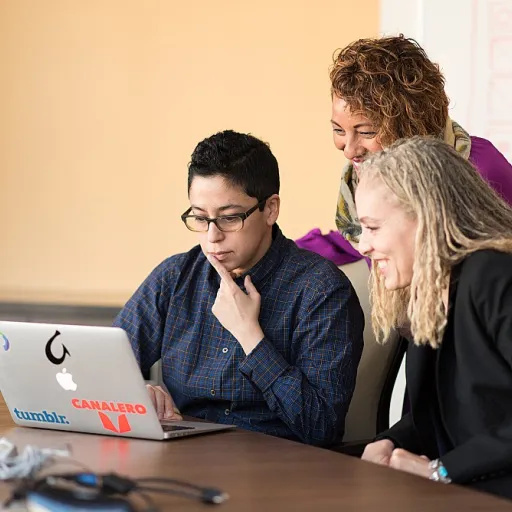
Understanding the Importance of Candidate Experience
The Foundation of Stronger Teams
Candidate experience serves as the bedrock for building cohesive teams. By fostering a positive initial interaction with potential employees, organizations lay the groundwork for effective teamwork and group dynamics, creating a culture of trust and collaboration. From the outset, focusing on candidate interactions can help mold not only the expectations but also the behaviors of future team members. This early emphasis on candidate experience is pivotal in shaping a cohesive team where members work synergistically towards shared objectives.
Building Trust and Cohesion
Trust is a fundamental pillar in any strong team. When candidates receive a transparent and engaging experience during the recruitment process, it enhances their trust in the organization. This trust spills over to their interactions with future team members, resulting in high levels of job satisfaction and an increased commitment to team goals. Moreover, candidates who experience an environment of fairness are more likely to develop a commitment to the team’s vision, leading to more cohesive teams.
Enhancing Accountability and Commitment
The early stages of candidate engagement can significantly influence long-term team dynamics. By instilling a sense of commitment and accountability from the get-go, candidate experience sets the tone for how team members will collaborate and resolve conflicts. This foundation aids in developing effective team strategies and promotes leadership development within the group. Accountability is a cornerstone of successful team building, and an enriching candidate experience can play a crucial role in cultivating these critical behaviors.
To dive deeper into the profound impact of storytelling on candidate morale, please refer to this insightful exploration on effective storytelling.
The Role of Communication in Candidate Experience
Fostering Effective Connections and Trust
Communication is a cornerstone of building a cohesive team and ensuring that candidates feel valued and informed throughout the recruitment process. Clear and consistent communication helps in developing trust among potential team members, setting the stage for a strong team dynamics. It’s essential not only to articulate the organizational vision and goals but also to engage in open dialogue—addressing candidates’ concerns and expectations effectively.
The transparency in communication establishes accountability and commitment, crucial for cohesive teams. When candidates are well-informed, they’re more likely to align with your company’s ethos and exhibit higher levels of job satisfaction, contributing to overall team cohesion.
Strategies for Effective Communication
Utilizing multiple channels—emails, calls, and meetings—ensures that communication is efficient and detailed. This approach helps in accommodating different preferences and ensures that no candidate feels left out. Providing timely updates on application status, offering detailed information about roles and responsibilities, and being responsive to queries are effective strategies in fostering a sense of trust and engagement.
Additionally, implementing communication practices that focus on feedback and improvement fosters a collaborative environment. Encouraging candidates to express their thoughts and incorporating their feedback can help refine the recruitment process, benefiting future interactions.
Building Cohesion Through Open Dialogue
Emphasizing open communication is vital for conflict resolution and commitment development among group members. By facilitating open discussions, organizations can address potential conflicts proactively, ensuring that individual behaviors align with group expectations.
Open dialogue also plays a pivotal role in onboarding and integrating new hires effectively. By encouraging new team members to share their experiences and insights, organizations can promote a culture of inclusion and support, leading to a more cohesive team.
For deeper insights on fostering an inclusive environment through communication strategies, explore the understanding the meaning of DEIJB in candidate experience.
Streamlining the Recruitment Process
Optimizing Processes for Better Recruitment Experiences
Streamlining the recruitment process is a vital step in building cohesive teams and enhancing candidate experience. To achieve this, organizations must consider several strategies to ensure that candidates feel valued and informed throughout their application journey. The recruitment process is often the first point of interaction between potential team members and the company. Ensuring that it runs smoothly sets the tone for a positive experience, which can lay the groundwork for trust and commitment. Here are some ways that companies can optimize this crucial phase:- Clear Job Descriptions: Providing comprehensive and clear job descriptions helps potential candidates understand the role, responsibilities, and the goals of the team. This clarity fosters interest among candidates who are genuinely aligned with the company's vision, contributing to stronger team cohesion from the onset.
- Efficient Communication: Communication is key in managing candidate expectations and keeping them engaged throughout the process. Timely updates about the application status can significantly impact the candidate's perception of the company’s efficiency and commitment to enhancing candidate experience.
- Structured Interview Process: A well-defined interview process involving multiple stakeholders from the team can provide diverse insights into a candidate’s fit for the role. It also helps candidates gain a deeper understanding of the team dynamics and behavior, which will be crucial when they become group members.
- Utilization of Technology: Leveraging technology to automate certain recruitment stages can reduce time and manual efforts, allowing HR professionals to focus on more strategic activities that build strong teams. This technological integration is essential in creating a seamless experience for candidates.
- Transparency in Decision Making: Being open about the selection criteria and the decision-making process cultivates trust among candidates. They appreciate understanding how their skills and behaviors fit into the larger vision of the company, reinforcing their sense of belonging to a cohesive team.
Feedback Mechanisms and Their Impact
Empowering Candidates Through Meaningful Feedback
Feedback mechanisms can significantly influence the candidate experience, impacting a candidate's likelihood to trust and accept an offer. When candidates receive timely and constructive feedback, it fosters a sense of inclusion and respect, encouraging them to see how their potential roles fit into overarching team goals. Meaningful feedback builds a foundation for candidates to understand and align themselves with the company's vision and goals, contributing to a cohesive team environment. Key strategies for implementing effective feedback mechanisms include:- Timeliness: Providing feedback promptly after interviews or assessments keeps candidates engaged and demonstrates that the organization respects their time and effort.
- Clarity: Clear and detailed feedback helps candidates identify areas for growth and understand the behavioral and technical aspects where they excel or need improvement.
- Positivity: While it's essential to address areas for improvement, positive reinforcement builds stronger candidates and, ultimately, more cohesive teams.
Onboarding: The First Step to Team Cohesion
Facilitating a Smooth Transition for Enhanced Team Cohesion
An effective onboarding process is crucial as it lays the groundwork for new team members and sets the stage for cohesive teams. When new members join, they bring unique perspectives, skills, and behaviors that, when properly integrated, can build a strong team dynamic. This integration doesn't happen spontaneously; it requires strategic onboarding processes to ensure team cohesion from the start.
A successful onboarding process should align with the company's vision and goals while fostering trust and commitment among team members. Clear communication about the team's work culture, expectations, and conflict resolution strategies is vital. This not only establishes a foundation of trust but also encourages accountability among group members.
Beginning the onboarding journey with tailored team-building activities can help new hires bond with existing team members. These activities also offer an opportunity to showcase behaviors that reflect the company’s values and vision, creating a more cohesive team. An effective onboarding experience includes introducing new hires to their roles and responsibilities, facilitating their understanding of how individual contributions lead to high levels of job satisfaction and team success.
Leadership development initiatives play a significant role in fostering team cohesion. New members should be familiarized with the leadership styles embraced within the organization, which helps mitigate potential conflicts and builds stronger relationships. Supporting new team members in developing self-awareness and empathy also contributes to a robust team dynamic.
Furthermore, providing time for social interactions between new and existing team members can strengthen bonds. When group members connect on a personal level, it enhances trust, collaboration, and overall team effectiveness. It's crucial that companies invest time and resources into developing onboarding processes that promote cohesiveness among their teams, ultimately leading to accomplishing organizational goals more efficiently.
Measuring Success: Evaluating Candidate Experience
Examining the Effectiveness of Your Hiring Strategies
Measuring the success of the candidate experience is crucial for building stronger teams. Evaluating this aspect not only helps identify areas for improvement but also ensures the alignment of recruitment practices with the company’s vision and goals. This evaluation can ultimately lead to higher job satisfaction and dedication among new team members.
There are several strategies to assess the effectiveness of candidate experience:
- Surveys and Feedback: Gathering feedback from candidates who went through the recruitment process can provide invaluable insights into their experience. Focus on understanding levels of communication, expectation setting, and how welcomed they felt. Effective communication throughout the recruitment process builds trust and lays the groundwork for cohesive team dynamics.
- Analysis of Recruitment Metrics: Examine metrics such as time-to-hire, offer acceptance rates, and candidate satisfaction scores. These metrics can reveal how well the recruitment process meets the needs of the candidates, which, in turn, influences team cohesion.
- Observing Team Development: After onboarding, assess how well new hires integrate into their teams. Indicators of successful integration include how quickly they align with team goals and the way their skills contribute to a strong team.
- Retention Rates: High levels of retention among new hires are often a sign of a positive candidate experience and effective onboarding process. It’s a marker that the group members are committed, and any potential conflict is managed effectively, fostering a strong team environment.
Regularly revisiting these metrics will guide leadership development and help refine recruitment practices. This will ensure cohesive teams that are not only efficient but also share a common purpose and commitment.













